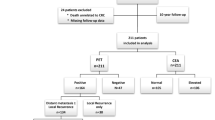Abstract
Purpose
The conventional diagnostic techniques used to assess recurrence of colorectal cancer (CRCR) often yield unspecific findings. Integrated FDG-PET/CT seems to offer promise for the differential diagnosis of benign and malignant lesions. The aim of this study was to compare the value of FDG-PET and PET/CT in the detection of CRCR subsequent to colonic resection or rectal amputation.
Methods
The population for this retrospective study comprised 84 patients with suspected CRCR. The sensitivity, specificity and accuracy of PET and PET/CT were calculated for (a) intra-abdominal extrahepatic recurrences, (b) extra-abdominal and/or hepatic recurrences and (c) all recurrences, and tumour marker levels were analysed.
Results
The sensitivity, specificity and overall accuracy of PET in detecting intra-abdominal extrahepatic CRCR were 82%, 88% and 86%, respectively, compared with 88%, 94% and 92%, respectively, for PET/CT. The corresponding figures for detection of extra-abdominal and/or hepatic CRCR were 74%, 88% and 85% for PET and 95%, 100% and 99% for PET/CT. Considering the entire population, the sensitivity, specificity and overall accuracy of PET were 80%, 69% and 75%, respectively, compared with 89%, 92% and 90%, respectively, for PET/CT. FDG-PET/CT examination correctly detected 40 out of a total of 45 patients with CRCR. Two of five patients with falsely negative FDG-PET/CT findings had local microscopic recurrences and one had miliary liver metastases. Of 39 patients without CRCR, three showed false positive FDG-PET/CT results. Two of these cases were due to increased accumulation in inflammatory foci in the bowel wall, while one was due to haemorrhaging into the adrenal gland.
Conclusion
FDG-PET/CT appears to be a very promising method for distinguishing a viable tumour from fibrous changes, thereby avoiding unnecessary laparotomy.



Similar content being viewed by others
References
Cohen AM, Minsky BD, Schilsky RL. Cancer of the colon. In: De Vita VT, Hellman S, Rosenberg SA, editors. Cancer: principle and practice of oncology. Philadelphia: Lippincott-Raven; 1997. p. 1144–1195
Reske SN, Kotzerke J. FDG-PET for clinical use. Eur J Nucl Med 2001;28:1707–1723
Burgener A, Kormano M. Differential diagnosis in computer tomography. Stuttgart: Georg Thieme; 1996
Schaefer-Prokop C, Jörgensen M. Gastrointestinal tract. In: Prokop M, Galanski M, editors. Spiral and multislice computed tomography of the body. Stuttgart: Georg Thieme; 2003. p. 543–593
Belohlavek O, Jaruskova M, Simonova K, Kantorova I. Atlas of positron emission tomography. Prague: Lacomed; 2002
Yamada K, Ishizawa T, Niwa K, Chuman Y, Aikou T. Pelvic exenteration and sacral resection for locally advanced primary and recurrent rectal cancer. Dis Colon Rectum 2002;45:1078–1084
de Lange EE, Fechner RE, Wanebo HJ. Suspected recurrent rectosigmoid carcinoma after abdominoperineal resection: MR imaging and histopathologic findings. Radiology 1989;170:323–328
Blomqvist L, Fransson P, Hindmarsh T. The pelvis after surgery and radio-chemotherapy for rectal cancer studies with Gd-DTPA-enhanced fast dynamic MR imaging. Eur Radiol 1998;8:781–787
Beets-Tan RG, Beets GL. Rectal cancer: review with emphasis on MR imaging. Radiology 2004;232:335–346
Beets-Tan RG, Beets GL, Borstlap AC, Oei TK, Teune TM, von Meyenfeldt MF, et al. Preoperative assessment of local tumor extent in advanced rectal cancer: CT or high-resolution MRI? Abdom Imaging 2000;25:533–541
Delbeke D, Vitola JV, Sandler MP, Arildsen RC, Powers TA, Wright JK Jr, et al. Staging recurrent metastatic colorectal carcinoma with PET. J Nucl Med 1997;38:1196–1201
Kantorova I, Lipska L, Belohlavek O. Routine 18F-FDG PET preoperative staging of colorectal cancer: comparison with conventional staging and its impact on treatment decision making. J Nucl Med 2003;44:1784–1788
Selvaggi F, Cuocolo A, Sciaudone G, Maurea S, Giuliani A, Mainolfi C. FDG-PET in the follow up of recurrent colorectal cancer. Colorectal Dis 2003;5:496–500
Antoch G, Saoudi N, Kuehl H, Dahmen G, Mueller SP, Beyer T, et al. Accuracy of whole-body dual-modality fluorine-18-2-deoxy-D-glucose positron emission tomography (FDG-PET/CT) for tumor staging in solid tumors: comparison with CT and PET. J Clin Oncol 2004;22:4357–4368
Hustinx R. PET imaging in assessing gastrointestinal tumors. Radiol Clin North Am 2004;42(6):1123–1139
Kamel IR, Cohade C, Neyman E, Fishman EK, Wahl RL. Incremental value of CT in PET/CT of patients with colorectal carcinoma. Abdom Imaging 2004;29:663–668
Even-Sapir E, Parag Y, Lerman H, Gutman M, Levine C, Rabau M, et al. Detection of recurrence in patients with rectal cancer: PET/CT after abdominoperineal or anterior resection. Radiology 2004;232:815–822
Cohade C, Osman M, Leal J, Wahl RL. Direct comparison of 18F-FDG PET and PET/CT in patients with colorectal carcinoma. J Nucl Med 2003;44:1797–1803
Kim JH, Czernin J, Allen-Auerbach MS, Halpern BS, Fueger BJ, Hecht JR, et al. Comparison between 18F-FDG PET, in-line PET/CT, and software fusion for restaging of recurrent colorectal cancer. J Nucl Med 2005;46:587–595
Flamen P, Stroobants S, Van Cutsem E, Dupont P, Bormans G, De Vadder N, et al. Additional value of whole body positron emission tomography with fluorine-18-2-fluoro-2-deoxy-d-glucose in recurrent colorectal cancer. J Clin Oncol 1999;17:894–901
Acknowledgements
The authors acknowledge the feedback they received from J. Dusa, P. Benes, D. Branciková, P. Bystricky, I. Knot, B. Donocikova, D. Dvoraková, R. Emmerova, M. Fridrichova, V. Hejzlarova, E. Helmichova, M. Chodacka, J. Jakesova, M. Jirasková, M. Kubecova, L. Lomska, P. Georgiev, M. Lukas, P. Maly, M. Matousek, V. Müller, L. Peterkova, M. Peskova, J. Prausova, L. Pohlova, P. Rihova, I. Sirak, M. Sejdova, P. Slauf, I. Stefanek, J. Svab, J. Svecova, M. Toberný and R. Zapletal.
Author information
Authors and Affiliations
Corresponding author
Rights and permissions
About this article
Cite this article
Votrubova, J., Belohlavek, O., Jaruskova, M. et al. The role of FDG-PET/CT in the detection of recurrent colorectal cancer. Eur J Nucl Med Mol Imaging 33, 779–784 (2006). https://doi.org/10.1007/s00259-006-0072-z
Received:
Accepted:
Published:
Issue Date:
DOI: https://doi.org/10.1007/s00259-006-0072-z




